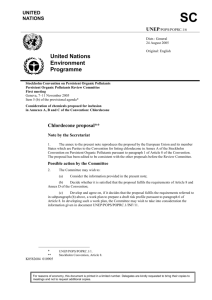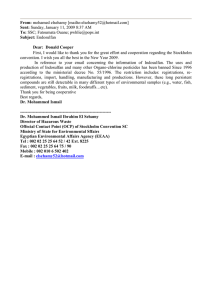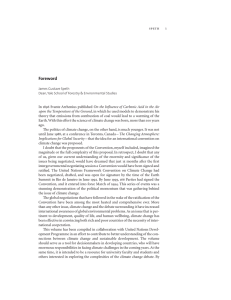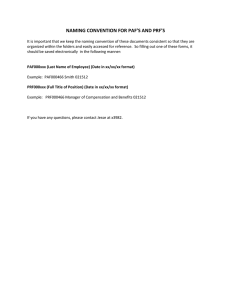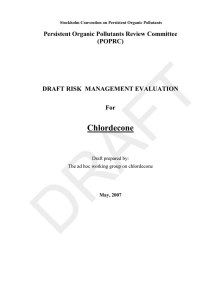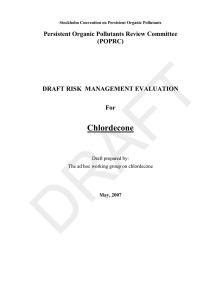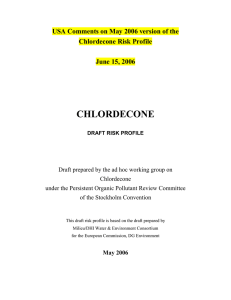Annex F Questionnaire (one per chemical)
advertisement
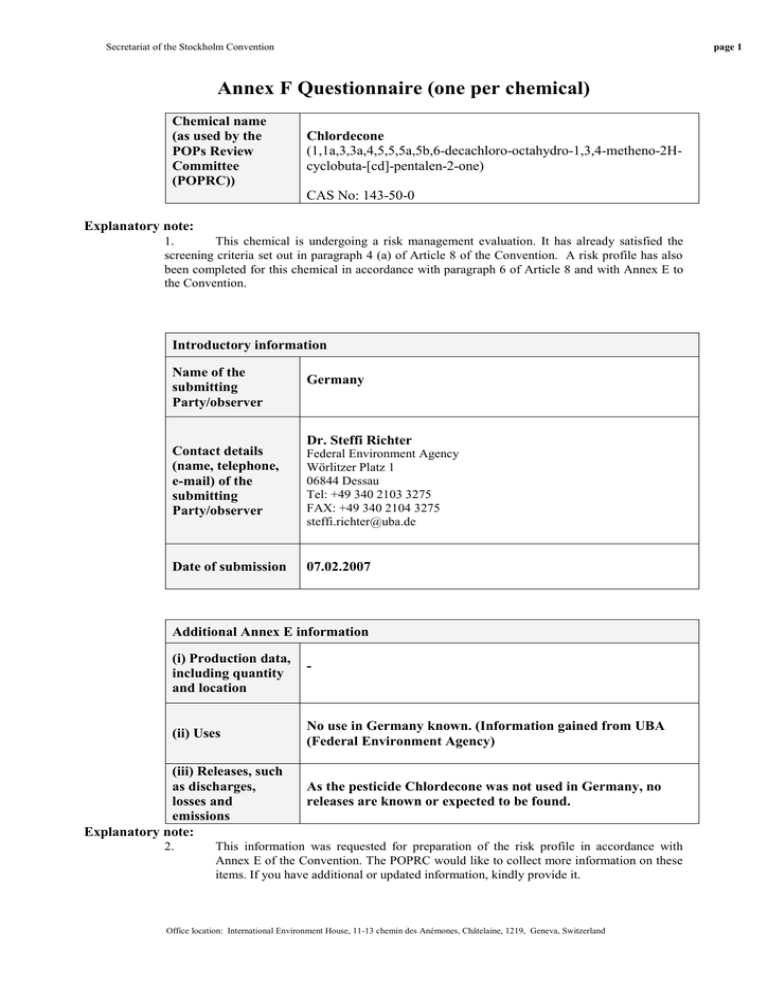
Secretariat of the Stockholm Convention page 1 Annex F Questionnaire (one per chemical) Chemical name (as used by the POPs Review Committee (POPRC)) Chlordecone (1,1a,3,3a,4,5,5,5a,5b,6-decachloro-octahydro-1,3,4-metheno-2Hcyclobuta-[cd]-pentalen-2-one) CAS No: 143-50-0 Explanatory note: 1. This chemical is undergoing a risk management evaluation. It has already satisfied the screening criteria set out in paragraph 4 (a) of Article 8 of the Convention. A risk profile has also been completed for this chemical in accordance with paragraph 6 of Article 8 and with Annex E to the Convention. Introductory information Name of the submitting Party/observer Contact details (name, telephone, e-mail) of the submitting Party/observer Date of submission Germany Dr. Steffi Richter Federal Environment Agency Wörlitzer Platz 1 06844 Dessau Tel: +49 340 2103 3275 FAX: +49 340 2104 3275 steffi.richter@uba.de 07.02.2007 Additional Annex E information (i) Production data, including quantity and location (ii) Uses (iii) Releases, such as discharges, losses and emissions Explanatory note: 2. - No use in Germany known. (Information gained from UBA (Federal Environment Agency) As the pesticide Chlordecone was not used in Germany, no releases are known or expected to be found. This information was requested for preparation of the risk profile in accordance with Annex E of the Convention. The POPRC would like to collect more information on these items. If you have additional or updated information, kindly provide it. Office location: International Environment House, 11-13 chemin des Anémones, Châtelaine, 1219, Geneva, Switzerland Secretariat of the Stockholm Convention page 2 A. Efficacy and efficiency of possible control measures in meeting risk reduction goals (provide summary information and relevant references): (i) Describe possible control measures No use of the pesticide chlordecon is known in Germany. Additionally, since …, a complete ban of Chlordecone as pesticide or as ingredient in pesticides is included in the national Pesticide-Application-Regulation (PflanzenschutzAnwendungsverordnung, §§ 1 and 5 (1)). (ii) Technical feasibility - (iii) Costs, including environmental and health costs - Explanatory notes: 3. If relevant, provide information on uses for which there may be no suitable alternative or for which the analysis of socio-economic factors justify the inclusion of an exemption when considering listing decisions under the Convention. Detail the negative impacts on society that could result if no exemption were permitted. 4. “Risk reduction goals” could refer to targets or goals to reduce or eliminate releases from intentional production and use, unintentional production, stockpiles, wastes, and to reduce or avoid risks associated with long-range environment transport. 5. Provide the costs and benefits of implementing the control measure, including environmental and health costs and benefits. 6. Where relevant and possible “costs” should be expressed in US dollars per year. B. Alternatives (products and processes) (provide summary information and relevant references): (i) Describe alternatives (ii) Technical feasibility (iii) Costs, including environmental and health costs Chlordecone is and was not used in Germany as pesticide. Most of our insectizides belong to the groups of pyrethroids, neonicotinoids, carbamates, organic phosphates and so-called „insect growth regulators“ (hormonal effect). (information gained from the pesticide experts at UBA) No comparison to chlordecone possible. No comparison to chlordecone possible. (iv) Efficacy No comparison to chlordecone possible. (v) Risk No comparison to chlordecone possible. (vi) Availability No comparison to chlordecone possible. Office location: International Environment House, 11-13 chemin des Anémones, Châtelaine, 1219, Geneva, Switzerland Secretariat of the Stockholm Convention page 3 No comparison to chlordecone possible. (vii) Accessibility Explanatory notes: 7. Provide a brief description of the alternative product or process and, if appropriate, the sector(s), use(s) or user(s) for which it would be relevant. 8. If several alternatives could be envisaged for the chemical under consideration, including non-chemical alternatives, provide information under this section for each alternative. 9. Specify for each proposed alternative whether it has actually been implemented (and give details), whether it has only reached the trial stage (again, with details) or whether it is just a proposal. 10. The evaluation of the efficacy should include any information on the performance, benefits, costs, and limitations of potential alternatives. 11. Specify if the information provided is connected to the specific needs and circumstances of developing countries. 12. The evaluation of the risk of the alternative should include any information on whether the proposed alternative has been thoroughly tested or evaluated in order to avoid inadvertently increasing risks to human health and the environment. The evaluation should include any information on potential risks associated with untested alternatives and any increased risk over the life-cycle of the alternative, including manufacture, distribution, use, maintenance and disposal. 13. If the alternative has not been tried or tested, information on projected impacts may also be useful. 14. Information or comments on improving the availability and accessibility of alternatives may also be useful. C. Positive and/or negative impacts on society of implementing possible control measures (provide summary information and relevant references): (i) Health, including public, environmental and occupational health (ii) Agriculture, including aquaculture and forestry \ As Germany does not use chlordecone, no impacts in the context of pesticide-use are expected from a regulation of chlordecone under the Stockholm Convention. On a global level, a positive impact on human health and on the environment can be expected from a ban of chlordecone. As Germany does not use chlordecone, no impacts in the context of pesticide-use are expected from a regulation of chlordecone under the Stockholm Convention. As Germany does not use chlordecone, no impacts in the context of pesticide-use are expected from a regulation of chlordecone under the Stockholm Convention. (iii) Biota (biodiversity) (iv) Economic aspects However, as the persistent, bioaccumulative and toxic properties of chlordecone were shown under the POPsProtocol and under the Stockholm Convention, a positive impact on biota from a ban/restriction of the substance can be expected. As Germany does not use chlordecone, no impacts in the Office location: International Environment House, 11-13 chemin des Anémones, Châtelaine, 1219, Geneva, Switzerland Secretariat of the Stockholm Convention page 4 context of pesticide-use are expected from a regulation of chlordecone under the Stockholm Convention. (v) Movement towards sustainable development As the persistent, bioaccumulative and toxic properties of chlordecone as well as it´s potential for a long-range transboundary transport were shown under the POPsProtocol and under the Stockholm Convention, a positive impact on a globally sustainable development from a ban/restriction of the substance is be expected. Furthermore, as Germany does not use chlordecone, no impacts in the context of pesticide-use on the national level are expected from a regulation of chlordecone under the Stockholm Convention. (vi) Social costs Explanatory notes: 15. - Socio-economic considerations could include: Any information on the impact (if any), costs and benefits to the local, national and regional economy, including the manufacturing sector and industrial and other users (e.g., capital costs and benefits associated with the transition to the alternatives); and impacts on agriculture and forestry; Any information on the impact (if any) on the wider society, associated with the transition to alternatives, including the negative and positive impacts on public, environmental, and occupational health. Consideration should also be given to the positive and negative impacts on the natural environment and biodiversity. Information should be provided on how control measures fit within national sustainable development strategies and plans. Office location: International Environment House, 11-13 chemin des Anémones, Châtelaine, 1219, Geneva, Switzerland Secretariat of the Stockholm Convention page 5 D. Waste and disposal implications (in particular, obsolete stocks of pesticides and clean-up of contaminated sites) (provide summary information and relevant references): There are no obsolete stocks of chlordecone expected to be found in Germany, as the pesticide was not applied here. But, the introduction of a critical threshold for chlordecone in waste (regulation 1195/2006/EC) will lead to measures taken in Germany as well. Responsible for the implementation of that regulation are the federal states (“Länder”). In Germany, for such topics a central instrument, the Federal/States-Working Group on Waste (LAGA- “Bund-Länder- Arbeitsgemeinschaft Abfall) was installed. This group will decide on and coordinate measures to be taken. (i) Technical feasibility (ii) Costs Further Regulations concerning the annexes of directive (EC) 850/2004 for POPs-containing waste are expected. These are related to tresholds and regulations of destruction measurements.A Working group of the Basel Convention established recently technical guidelines, which have been adopted in 2005 (“Technical guidelines for the environmentally sound management of wastes consisting of, containing or contaminated with polychlorinated biphenyls (PCBs), polychlorinated terphenyls (PCTs) or polybrominated biphenyls (PBBs)’and ‘General technical guidelines for the environmentally sound management of wastes consisting of, containing or contaminated with persistent organic pollutants (POPs)’) (Source, German NIP, 2006) At the current moment, there is no information on arising costs available. Explanatory note: 16. Specify if the information provided is connected to the specific needs and circumstances of developing countries. E. Access to information and public education (provide summary information and relevant references): Explanatory note: 17. Please provide details here of access to information and public education with respect to both control measures and alternatives. Office location: International Environment House, 11-13 chemin des Anémones, Châtelaine, 1219, Geneva, Switzerland Secretariat of the Stockholm Convention F. Status of control and monitoring capacity (provide summary information and relevant references): Explanatory note: 18. With regard to control capacity, the information required is on legislative and institutional frameworks for the chemical under consideration and their enforcement. With regard to monitoring capacity, the information required is on the technical and institutional infrastructure for the environmental monitoring and biomonitoring of the chemical under consideration, not monitoring capacity for alternatives. G. Any national or regional control actions already taken, including information on alternatives, and other relevant risk management information: POPs-Protocol Chlordecone is listed in Annex I of the POPs-Protocol under LRTAP OSPAR: Chlordecone is included in the list of substances of possible concern. Additional information on legal provisions: Germany: - Complete ban of Chlordecone as pesticide or as ingredient in pesticides (Pesticide-Application-Regulation (Pflanzenschutz-Anwendungsverordnung), §§ 1 and 5 (1)) - There was one exemption under the national list of approved measures for abatement of animal pests (§18 Act of infection prevention, Infektionsschutzgesetz) for the use of Chlordecone against pharaoh ants. This excemption was elimated, however, in 2002. EU: New European Chemical Policy: - Under the new REACH system, substances with persistent, bio-accumulative and toxic properties (PBT) or very persistent and very bio-accumulative properties (vPvB) will be systematically identified and subjected to an authorisation procedure. (NIP, p. 37). The PBT criteria under REACh are currently under review (deadline 1.12.2008). Waste: - Regulation 850/2004/EC was lately amended by regulation 1195/2006/EC in order to include tresholds for POPs-containing waste, such as chlordecone. Thus, wastes that are known to consist of, contain or be contaminated with Chlordecone and that exceed the lower concentration limits of 50 mg/kg are disposed of. Office location: International Environment House, 11-13 chemin des Anémones, Châtelaine, 1219, Geneva, Switzerland page 6 Secretariat of the Stockholm Convention page 7 Explanatory notes: 19. Actions or measures taken could include prohibitions, phase-outs, restrictions, cleanup of contaminated sites, waste disposal, economic incentives, and other non-legally binding initiatives. 20. Information could include details on whether these control actions have been cost-effective in providing the desired benefits and have had a measurable impact on reducing levels in the environment and contributed to risk reduction. H. Other relevant information for the risk management evaluation: Explanatory notes: 21. The above list of items is only indicative. Any other relevant information for the risk management evaluation should also be provided. I. Other information requested by the POPRC: [Note to the Secretariat] ___________________ Office location: International Environment House, 11-13 chemin des Anémones, Châtelaine, 1219, Geneva, Switzerland
